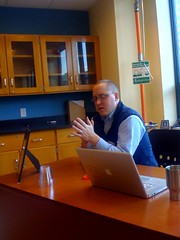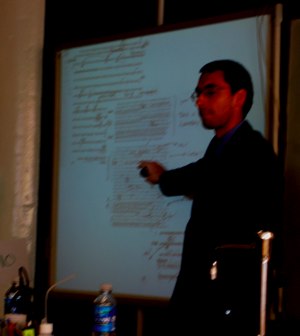 We just finished the opening panel discussion, which included Will Richardson, Gary Stager, Joyce Valenza, Sylvia Martinez, David Jakes, Chris Lehmann, and it was brilliant. There were big questions and lots of short answers. But all together their short answers spoke volumes.
We just finished the opening panel discussion, which included Will Richardson, Gary Stager, Joyce Valenza, Sylvia Martinez, David Jakes, Chris Lehmann, and it was brilliant. There were big questions and lots of short answers. But all together their short answers spoke volumes.
Right now, I’m in the social networking session, presided over Glenn Moses, who is the tech director for a virtual school in Los Vegas. He’s calling attention to the National School Boards Association study about students’ use of their social networkings. So what are social networks and social networking? Do we need to integrate social networks(ing) into our classes? ..or do we need to create assignments or work for our students that demands them to use social networking. This is the conversation. Also being talked about is the technology of it. HOw do you bring it in and protect the kids.
Now in Konrad Glogowski’s session, called “The Embedded Practitioner” or “Becoming Teacher 2.0”. He’s a middle school teacher and doctoral student. I’ve never met this man before, but have heard his name in the context of my favorite conversations for years. His blog is at http://teachandlearn.ca/blog/.
 |
| This is how Konrad taught English before he started creating community through conversations (blogging). Funny! |
Konrad described the process of setting up his doctoral research, and decided to simply set up his 8th grade students with blogs, and then let them go, observing. On his slide he says, “Student participation necessitated a shift in my classroom practice.” He says that he moved toward working to create a community in his classroom, though their writing and his writing. …and part of that was realizing and valuing the fact that his students were individuals and had the right to express their own stories.
Now he wants to talk about Caravaggio (1571-1610).
| I think it’s cool that he has us looking up stuff on Wikipedia without asking us to. |
He was in the practice of including himself into his paintings. Rarely, was he part of the action, but in the background observing, and appearing to be making a comment about what’s happening. In a sense, this is how Konrad thinks about his use of blogging in his classrooms. He’s observing and sometimes commenting on his students conversations. I really like the way that Konrad is explaining his evolving position as a teacher by comparing himself with Caravaggio.
So what does this mean?
- We need unauthorized methods.
- external experts should no longer determine what we do andhow we do it.
- Create communities of learning.
- need to get to know and interact with our learners.
To get his students to reflect on their blogging (not commenting), he showed them a picture of a small town, a community. Then he asked the students to identify, in the picture, the person or thing that they felt represented their work. He then turned their selections into an image map, where students could click an object in the online version of the picture, and go to the blogger. Brilliant! It’s about community. It has to do with losing your teacherie voice.
He mentions a research (Ray Oldenburg) who talks about third places. First place is home, and second place is work. Your third place where you go to meet and interact with people.
Konrad’s classes use 21 Classes for their blogging engine, because it has not themes. Students can dress their blog to look the way that they want it to. The blog becomes their third place.

I think that you will find that his expression is “losing the teacherly voice” which is a Leigh Blackall phrase (make sure you read the comments where Konrad weighs in) and one that Konrad has adopted for his use.
Cheers,
Graham.
Sorry the URL for the Leigh Blackall post was http://learnonline.wordpress.com/2007/10/12/to-facilitate-or-to-teach/ – I missed something in the HTML tags.
First education bent to the will of industry in the way classes were taught and what was taught. Now we are to bend to social networks because kids use them? I do not feel that a social network is indicative of technological literacy when those same kids in my school who use such networks cannot hyperlink text, use GoogleDocs or even use MS Word properly. In doing so, are we not just using technology for the sake of using technology? Turn Facebook and the like into safe educational tools and then talk to me about using them to teach. Until then, I’ll stick to my web page, Quia, blogs and wikis.
Doug,
I think blogs are part of a social network, actually, because they make us and our students “clickable.”
And I think that social networks that allow students to connect beyond the box of their own school are transformative educational tools. Social networks are of course more than Facebook, and more than one tool or platform. They’re about connecting people.
We’re here because we all connected to David’s blog, and likewise, your students are able to connect to ideas from everywhere.
But I think we do have to be open to other networking tools like Ning for example allows two teachers to collaborate and create a space for students at two schools across the globe to plan projects, share ideas, comments, blog posts, discussion boards, etc.
I think there is much learning to be done while we connect with others(and maybe those others will also peer tutor your students through learning how to link or use MS Word, or whatever the learning task might be at any given moment).
David, I also am glad you highlighted Konrad Glogowski’s session, which was an incredible example of a teacher sharing how bringing in a new tool to his teaching completely transformed how he works with students. His presentation was truly a light to guide us by.